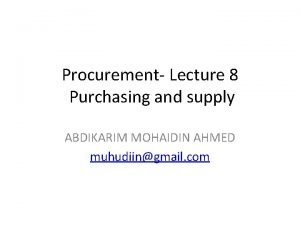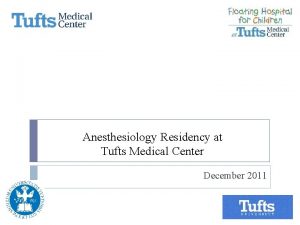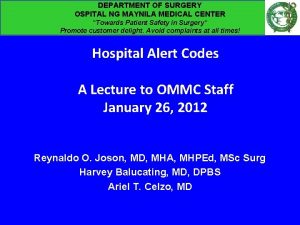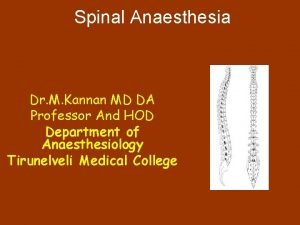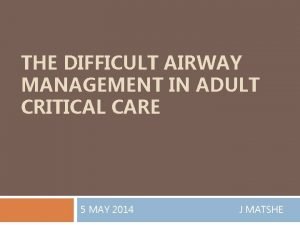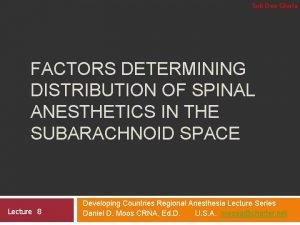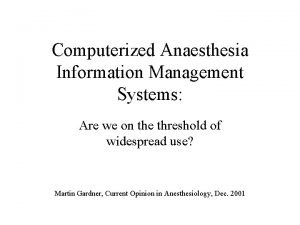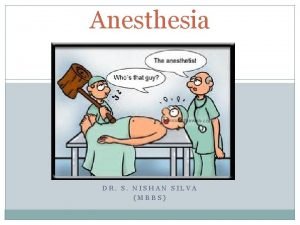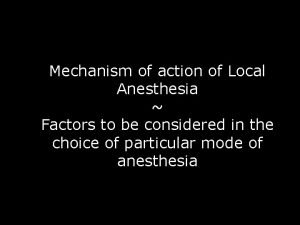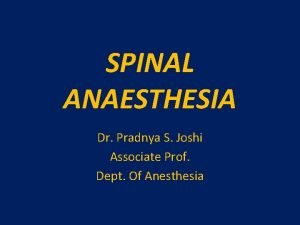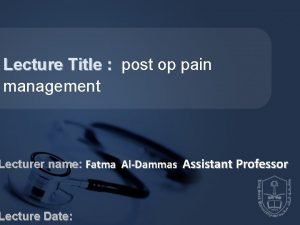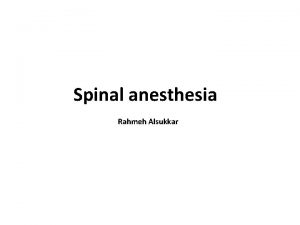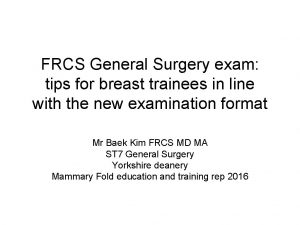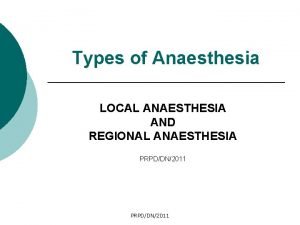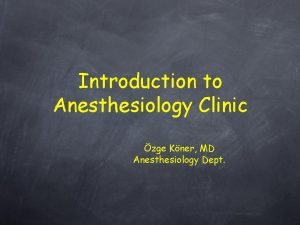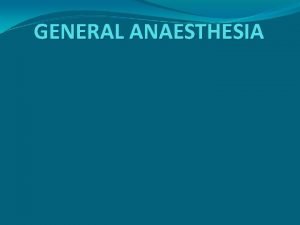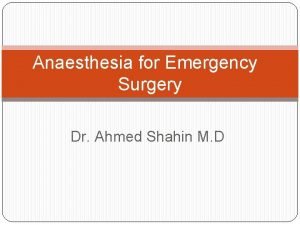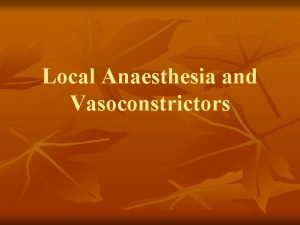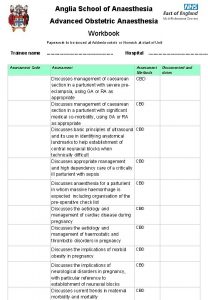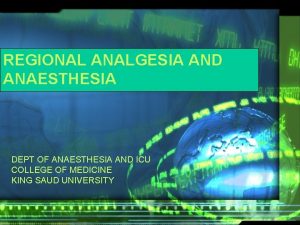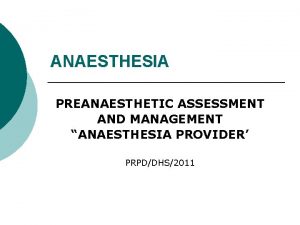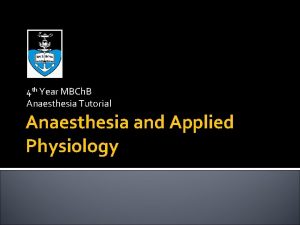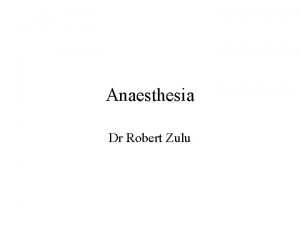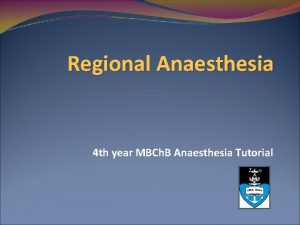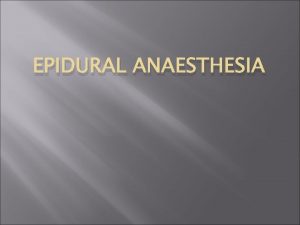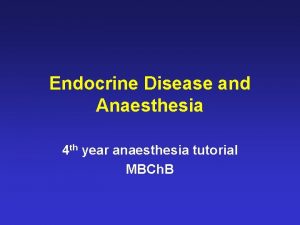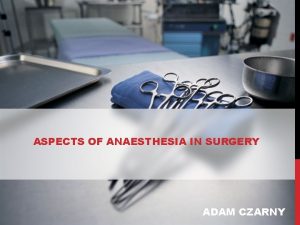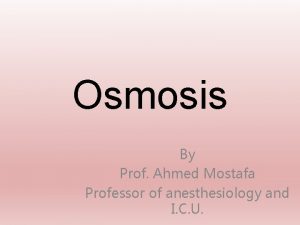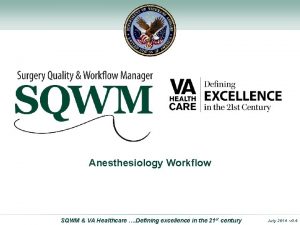GENERAL ANAESTHESIA Department of Surgery Anesthesiology Dr Ahmed



















- Slides: 19

GENERAL ANAESTHESIA Department of Surgery Anesthesiology Dr. Ahmed Haki Ismael

What is Anaesthesia ? ? ? • Anesthesia – is a reversible condition of comfort, quiescence and physiological stability in a patient before, during and after performance of a procedure • General anesthesia – for surgical procedure to render the patient unaware / unresponsive to the painful stimuli – Drugs producing G. Anaesthesia – are called General Anaesthetics • Local anesthesia - reversible inhibition impulse generation and propagation in nerves. In sensory nerves, such an effect is desired when painful procedures must be performed, e. g. , surgical or dental operations – Drugs producing Local Anaesthesia – are called Local Anaesthetics e. g. Procaine, Lidocaine and Bupivacaine etc.

General anaesthetics (Defn. ) • General Anaesthetics are the drugs which produce reversible loss of all sensation and consciousness, or simply, a drug that brings about a reversible loss of consciousness • Remember !!! These drugs are generally administered by an anesthesiologist in order to induce or maintain general anesthesia to facilitate surgery General anaesthetics are – mainly inhalation or intravenous •

Essential components of GA: • Cardinal Features: – – • Loss of all sensations Sleep and Amnesia Immobility or Muscle relaxation Abolition of reflexes – somatic and autonomic Clinically – What an Anaesthetist wants ? ? ? – Triad of GA • need for unconsciousness • need for analgesia • need for muscle relaxation

What are the Drugs used as GA ? (Classification) • Inhalation: 1. Gas: Nitrous Oxide 2. Volatile liquids: • • • Ether Halothane Enflurane Isoflurane Desflurane Sevoflurane • Intravenous: 1. Inducing agents: • Thiopentone, Methohexitone sodium, propofol and etomidate 2. Benzodiazepines (slower acting): • Diazepam, Lorazepam, Midazolam 3. Dissociative anaesthesia: • Ketamine 4. Neurolept analgesia: • Fentanyl

d n a n g i s ! ! ! s s d n s e tag a s n s g i e n s g g f i a t o ss S e n l ` ) o l r b i r t e e olu u p d h i o t r e s c F E u ( s f d G i e o lip 4 t d D s e l e a s l l h a cal e a c d v n c l e u o o lyz i n t v S i o i m n N e i ara d Als en y C a r r r f e p e a o v s • T e n n i r A s sio y l a l ra lla a G b a f s n c e s of o i o u r i t d p p e c y e • T low a ing d r area d in m d • S escen o lowelocate t r D e • igh nters • H ital ce • V

Stages of GA Stage I: Stage of Analgesia • Starts from beginning of anaesthetic inhalation and lasts upto the loss of consciousness • Pain is progressively abolished during this stage • Patient remains conscious, can hear and see, and feels a dream like state • Reflexes and respiration remain normal • It is difficult to maintain - use is limited to short procedures only

stages of GA – contd. Stage II: Stage of Delirium and Excitement: • • From loss of consciousness to beginning of regular respiration Excitement - patient may shout, struggle and hold his breath Muscle tone increases, jaws are tightly closed. Breathing is jerky; vomiting, involuntary micturition or defecation may occur. Heart rate and BP may rise and pupils dilate due to sympathetic stimulation. No stimulus or operative procedure carried out during this stage. Breatholding are commonly seen. Potentially dangerous responses can occur during this stage including vomiting, laryngospasm and uncontrolled movement. This stage is not found with modern anaesthesia – preanaesthetic medication, rapid induction etc.

stages of GA – contd. • Stage III: Stage of Surgical anaesthesia – Extends from onset of regular respiration to cessation of spontaneous breathing. This has been divided into 4 planes: – Plane 1: Roving eye balls. This plane ends when eyes become fixed. – Plane 2: Loss of corneal and laryngeal reflexes. – Plane 3: Pupil starts dilating and light reflex is lost. – Plane 4: Intercostal paralysis, shallow abdominal respiration, dilated pupil.

stages of GA – contd. Stage IV: Medullary / respiratory paralysis • Cessation of breathing failure of circulation death • Pupils: widely dilated • Muscles are totally flabby • Pulse is imperceptible • BP is very low.

signs & stages of GA – contd.

But not seen these days, because! • Availability of rapidly acting agents – IV as well as Inhalation • Mechanical control of Respiration • Pre-operative and post operative Drugs – Atropine – dilate pupil, Opioid – depressing of respiration and SMRs • Important signs observed by anaesthetists: – If no response to Painful stimulus - stage III – On Incision - rise in BP, respiration etc. – light anaesthesia – Fall in BP, respiratory depression – deep anaesthesia • Modern methods: Monitoring of Vital signs by CAM (computer assisted monitoring)

Practically what is done in OT ? ? ? • There are 3 (three) phases: – Induction, Maintenance and Recovery • Induction (Induction time): It is the period of time which begins with the beginning of administration of anaesthesia to the development of surgical anaesthesia (Induction time). – Induction is generally done with IV anaesthetics like Thiopentone Sodium and Propofol • Maintenance: Sustaining the state of anaesthesia. Usually done with an admixture of Nitrous oxide and halogenated hydrocarbons • Recovery: At the end of surgical procedure administration of anaesthetic is stopped and consciousness regains (recovery time)

BLOOD GAS PARTITION CO-EFFICIENT

Elimination of GA • Mostly through lungs in unchanged form • Channel of absorption (lungs) become channel of elimination • Generally, Enter and persists in adipose tissue for long periods – high lipid solubility and low blood flow • Muscles become intermediates in that process • Excreted unchanged except Halothane • Recovery may be delayed in prolonged anaesthesia

Elimination of GA – contd. • Second gas effect: Seen only wit N 2 O – Initially, more and more gas will go to blood irrespective of tidal volume or minute volume (because patient is ventilated) – For Example, N 2 O and Halothane are given as mixture (commonly) • N 2 O will be sucked in fast in a few minutes carrying along Halothane at the same rate • Induction becomes faster • Diffusion hypoxia: – Reverse happens during recovery: discontinue N 2 O – Diffuses to alveoli and dilutes air in alveoli (otherwise being maintained) – Oxygen is reduced – hypoxia occurs in low cardiopulmonary patients – Treatment: Oxygen Inhalation

Techniques of inhalation GA • Open drop method • Through anaesthetic machines - Open system - Closed system - Semi-closed system

Continuous flow (Boyle’s) anaesthetic machine Anaesthetic Machine (Boyle’s equipment) • The anaesthetic machine • Gas source- either piped gas or supplied in cylinders • Flow meter • Vaporisers • Delivery System or circuit

Properties of GA – contd. • For Patient: - Pleasant, non-irritating and should not cause nausea or vomiting - Induction and recovery should be fast • For Surgeon: - analgesia, immobility and muscle relaxation - nonexplosive and noninflammable • For the anaesthetist: 1. Margin of safety: No fall in BP 2. Heart, liver and other organs: No affect 3. Potent 4. Cheap, stable and easily stored 5. Should not react with rubber tubing or soda lime 6. Rapid adjustment of depth of anaesthesia should be possible
 Ahmed muhudiin ahmed
Ahmed muhudiin ahmed Umass neurology residency
Umass neurology residency Tufts anesthesia residency
Tufts anesthesia residency Ospital ng maynila address
Ospital ng maynila address Wvu department of surgery
Wvu department of surgery Structures pierced during spinal anaesthesia
Structures pierced during spinal anaesthesia 332 rule intubation
332 rule intubation Balanced anaesthesia ppt
Balanced anaesthesia ppt Balanced anesthesia components
Balanced anesthesia components What is regional anesthesia
What is regional anesthesia What is gag reflex mean
What is gag reflex mean Anaesthesia information management system
Anaesthesia information management system Balanced anesthesia components
Balanced anesthesia components Sanjita das
Sanjita das Composition of local anesthesia
Composition of local anesthesia Site:slidetodoc.com
Site:slidetodoc.com Spinal anaesthesia position
Spinal anaesthesia position Bromage scale
Bromage scale Lumbar puncture structures pierced
Lumbar puncture structures pierced Frcs exam questions
Frcs exam questions
